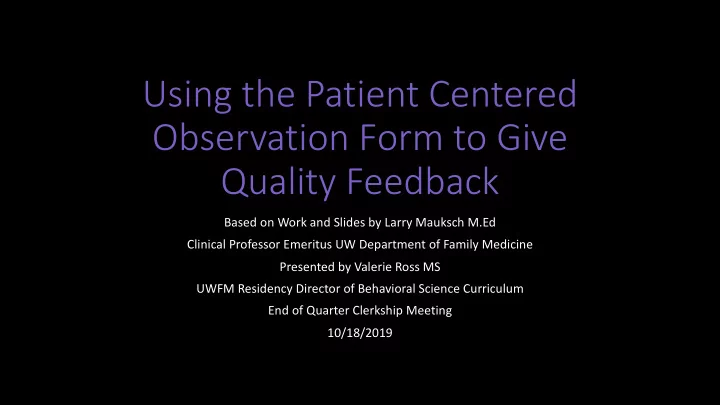

Using the Patient Centered Observation Form to Give Quality Feedback Based on Work and Slides by Larry Mauksch M.Ed Clinical Professor Emeritus UW Department of Family Medicine Presented by Valerie Ross MS UWFM Residency Director of Behavioral Science Curriculum End of Quarter Clerkship Meeting 10/18/2019
Miller’s Assessment Pyramid Miller, G. E. The assessment of clinical skills/competence/performance. 1990 Acad Med 65 (9 Suppl): S63-7. Adapted from Holmboe and Hawkins. Evaluation of Clinical Competence, Mosby 2008 Impact on the patient • Faculty observation (with real patients) Does Shows • Standardized patients how • Matching or critical Knows how response questioning • Multiple choice Knows questions 2
Mastering a Skill Domain Practice • Real situations • Learned from expert: • description • demonstration Reflection Feedback • Specific • Promotes analysis • Sensitive • Synthesis • Developmentally • Integration appropriate
Observation Form Purpose and Training The value • Structures vision • Creates and standardizes vocabulary Primarily for formative assessment and to strengthen the “observer self” (mindfulness)
PCOF Use Behavior in either of the columns to the right of thick vertical line is in the competent range Observers mark accurately and avoid giving the benefit of the doubt Feedback is When Specific, rather Curious, not best: solicited than general judgmental Larry Mauksch, M.Ed University of Washington Department of Family Medicine
Language Structures Thought and Behavior Inarticulate Articulate • The art of medicine • Emotional and cognitive cues • Good bedside manner • Agenda setting • TLC • Teachback • Touchy-feely stuff • Continuer phrases • Engagement • Transparent thinking • Listening • Illness explanatory Model Larry Mauksch, M.Ed University of Washington Department of Family Medicine
Relationship Communication and Efficiency: Creating a Clinical Model from a Lit Review Mauksch et al, 2008, Arch of Intern Med, 168 (13) 1387-1395 Ongoing influence Rapport and Sequential Relationship Mindfulness 2. Hypothesis testing 1. Upfront 3. Co-creating and understanding collaborative the patient a plan agenda setting Topic Tracking perspective Empathic SMS: problem solving response to cues
It is more about you than the tool van der Vleuten et al The assessment of professional competence: building blocks for theory development. Best Pract Res Clin Obstet Gynaecol. Dec 2010;24(6):703-719 Trained faculty offer formative assessment influenced by context and focused on need in ways that checklists can not provide Multiple observations with purposeful sampling by multiple expert raters offering authentic assessments may provide a more valid picture of “does” than quantitative tools
Video 1
Discuss Find a partner: •What was done well? •What could be improved? •What would be your first suggestion for improvement? Larry Mauksch, M.Ed University of Washington Department of Family Medicine
Video 2
Discuss Find a partner: •What was done well? •What could be improved? •What would be your first suggestion for improvement? Larry Mauksch, M.Ed University of Washington Department of Family Medicine
Share: Success, Challenges, Tips Form a small group at your table. Think about and then share: • What successes have you had using the PCOF and giving formative feedback? What are you doing that contributed to successful feedback and learning on the part of your students? • What challenges have you had? • What are possible solutions or tips to address those challenges? • New ideas as a result of today?
Recommend
More recommend